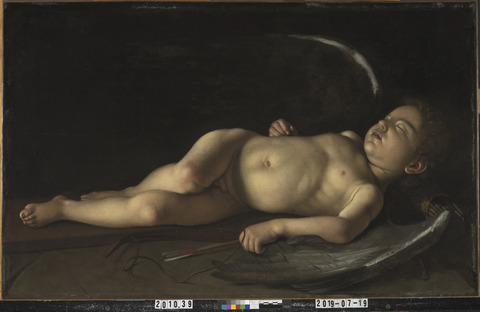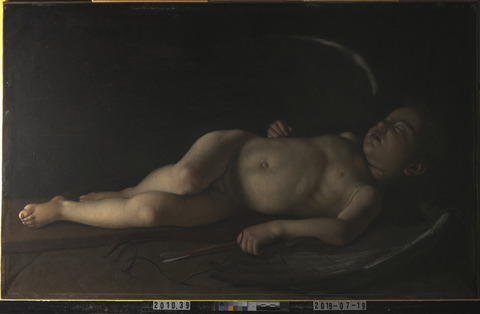Overview
Identification number: 2010.39
Artist: After Michelangelo Merisi da Caravaggio
Title: Sleeping Cupid
Materials: Oil on canvas
Date of creation: About 1610–1615
Previous number/accession number: C10016
Dimensions: 65.8 × 104.8 cm
Conservator/examiner: Roxane Sperber
Examination completed: 2019
Distinguishing marks:
Front:
None
Back:
Item 1. “Caravaggio Sleeping Eros,” handwritten in black marker, top horizontal stretcher bar. (tech. fig. 1)
Item 2. “Clowes Fund Collection/ Indianapolis,” handwritten in black marker, central horizontal stretcher bar. (tech. fig. 1)
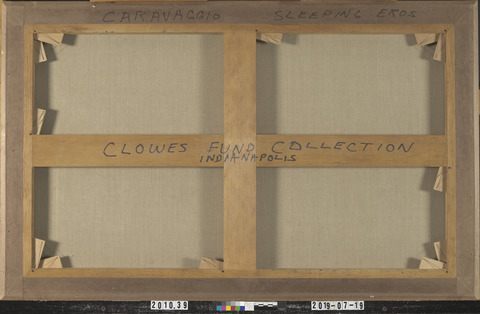
Summary of Treatment History
The painting has undergone numerous interventions that have greatly impacted its visual appearance. The painting was overpainted to transform Cupid into the Christ child (tech. fig. 2). This was noted by Walter Friedlaender in Caravaggio Studies, where he wrote, “When this painting was recently discovered in the possession of the New York art dealer, it was thinly but completely overpainted with the figure of a Christ-Child sleeping, his head upon a crown of thorns."1 This overpaint was subsequently removed in what Friedlaender describes as an “extremely cautious cleaning.” 2 However, the severely abraded condition of the work contradicts this description.
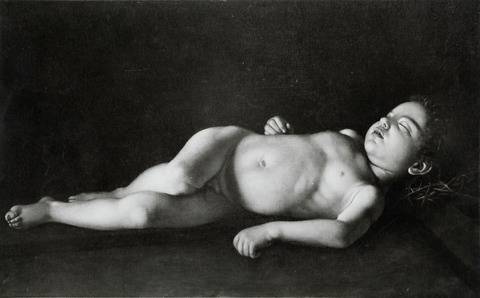
Documentation suggests a series of condition assessments and treatments were carried out on the collection around the time the works were moved from the Clowes' residence to the IMA in 1971. A condition report by Paul Spheeris in October of that year, likely carried out before the paintings were relocated, described the painting as having “some kind of drip below cupids [sic] ear, abrasion in upper right corner, white splotch in wing at top.” Nevertheless, he did not recommend treatment of the work at that time.3 A second condition assessment was carried out upon arrival of the paintings at the IMA. This assessment comments that 12 X-radiographs were taken of the painting in addition to black-and-white photographs.4
A full treatment was carried out at the IMA in the early 1970s. The treatment included removing a surface coating, as well as previous retouching that was judged to have been carried out in a varnish media, using methanol and methyl ethyl ketone. During the treatment, the conservator noted that the painting had likely been treated at least twice before coming to the IMA. They also noted the presence of overpaint that had not been completely removed after the large-scale repainting of the figure. The conservator judged this overpaint to have a solubility that was close to the original paint layer making it difficult to remove, perhaps accounting for the severely damaged state of large sections of the painting. While it was possible to remove some overpaint, other areas were left untouched and were instead addressed through inpainting. The painting was varnished with Paraloid B-72 varnish. The medium used for inpainting was not noted. The condition report notes the presence of an “aqueous adhesive relining” as well as brown tape on the edges, suggesting the lining was carried out before coming to the IMA on long-term loan.5
In 1974, a condition assessment, treatment, and investigation of the collection was carried out by the Intermuseum Conservation Association at Oberlin College. This document described this painting as not in need of treatment, suggesting the aforementioned treatment was before 1974.6
In 1996, a memorandum summarizing treatment and examination of the Clowes Collection from the time it entered the IMA noted that the painting was currently the subject of a major technical and art historical research project by museum staff, including photographic documentation, X-radiography, infrared reflectography, and comparative study with national and international experts through both correspondence and firsthand examination.7
By May of 2000, the painting was exhibiting issues such as visible fingerprints and bloom in the varnish, which needed to be addressed before the painting could go on loan.8 Treatment of the painting was carried out in September of that year. The fingerprints were removed using deionized water. This also reduced the bloom. The painting was sprayed with Paraloid B-72 and inpainted using Gamblin Conservation Colors in isopropanol. Difficulty with integrating the highly inpainted surface without removing the previous treatment was noted.9
On 1 April 2003, a small scratch on the painting was reported. The varnish was reformed using toluene to obscure the scratch.10
The disruptive appearance of the damaged background was again addressed in preparation for exhibition in 2019 through localized inpainting by Senior Paintings Conservator Linda Witkowski.
Current Condition Summary
The painting is in structurally stable condition. The support is secure and in good condition, and the painting is well adhered to the lining canvas. The painting has suffered from severe abrasion to the paint layer, particularly in the background of the figure but also in the glazed shadows.
Methods of Examination and Imaging
| Examination/Imaging | Analysis (no sample required) | Analysis (sample required) |
|---|---|---|
| Unaided eye | Dendrochronology | Microchemical analysis |
| Optical microscopy | Wood identification | Fiber ID |
| Incident light | Microchemical analysis | Cross-section sampling |
| Raking light | Thread count analysis | Dispersed pigment sample |
| Reflected/specular light | X-ray fluorescence spectroscopy (XRF) | Fourier-transform infrared spectroscopy (FTIR) |
| Transmitted light | Macro X-ray fluorescence scanning (MA-XRF) | Raman microspectroscopy |
| Ultraviolet-induced visible fluorescence (UV) | ||
| Infrared reflectography (IRR) | Gas chromatography–mass spectrometry (GC-MS) | |
| Infrared transmittography (IRT) | Scanning electron microscope -energy dispersive X-ray spectroscopy (SEM-EDS) | |
| Infrared luminescence | Other | |
| X-radiography |
Technical Examination
Description of Support
Analyzed Observed
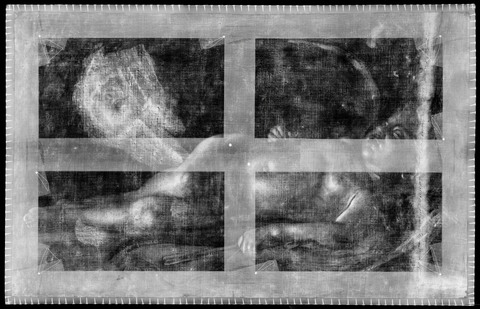
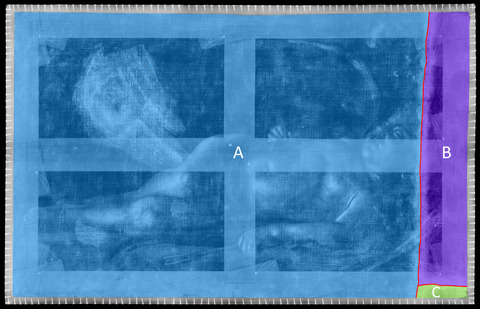
Material Type (fabric, wood, metal, dendrochronology results, fiber ID information, etc.):
The support is constructed from three pieces of canvas. Automated thread count analysis by Don Johnson at the Threat Count Automation Project found all three pieces of canvas to be a plain (rectilinear) pattern.11 Thread count analysis (see table 1) found the pieces of canvas to differ in thread density, suggesting they are from different sources.12
Thread density of original canvas:
| Horizontal thread density average (threads/cm) | Vertical thread density average (threads/cm) | |
|---|---|---|
| Canvas section A | 10 | 11.1 |
| Canvas section B | 10.3 | 14.7 |
| Canvas section C | 8.8 | 10.2 |
Table 1: Thread density on three pieces of canvas as analyzed by the Threat Count Automation Project.
Characteristics of Construction/Fabrication (cusping, beveled edges of panels, seams or joins, battens):
The three pieces of canvas are joined by two seams: one vertical seam and one horizontal seam (see red lines, tech. fig. 3). The largest piece of canvas extends from the left edge of the painting to the top of Cupid’s head on the right side of the canvas where there is a vertical seam (see section A blue, tech. fig. 3). There is a weft snake, weave anomaly, running along the right side of the edge of the canvas section A. This indicates the vertical threads correspond to weft threads. A second strip of canvas is attached to the right edge of the canvas (see section B purple, tech. fig. 3). This strip does not extend to the bottom of the picture plane. Rather, there is a seam at the bottom of the strip of canvas that attaches to a third, small rectangle of canvas on the lower-right corner of the canvas (see section C green, tech. fig. 3). It was not possible to determine the weave direction of the canvas threads on canvas sections B or C.
Thread angle maps identified strong cusping along the bottom edge and left edge of the canvas section A. This can also be observed in the X-radiograph. Much less prominent cusping was also present on the upper edge, and no cusping was visible on the right edge of canvas section A. Comparison of the cusping depths suggests at least 20 cm was trimmed from the top edge and right edge of canvas section A after the canvas was prepared. Cusping patterns do not extend to canvases B and C, suggesting these pieces were added after canvas section A was stretched and prepared.13
The painting has been glue-paste lined with a plain-weave canvas before coming to the IMA. The lining canvas has a slightly tighter weave (16 × 22 threads/cm) than the original canvases. The original tacking margins have been removed, likely when the painting was lined, and the dimensions of the canvas have been extended by the lining canvas. The edges of the canvas have been covered with brown tape.
Thickness (for panels or boards):
N/A
Production/Dealer’s marks:
None
Auxiliary Support:
Original Not original Not able to discern None
The painting is on a six-member stretcher with a single horizontal and vertical crossbar (tech. fig. 1). The corners joints are full mitered bridle joints. The crossbars are joined with slot mortise and tenon joints. 14
Condition of Support
The support is in generally stable condition. The lining canvas is in good condition and is supporting the seams in the original canvas, which are in plane and largely imperceptible. The original tacking margins have been removed. There are no apparent losses to the original canvas or lining canvas.
Description of Ground
Analyzed Observed
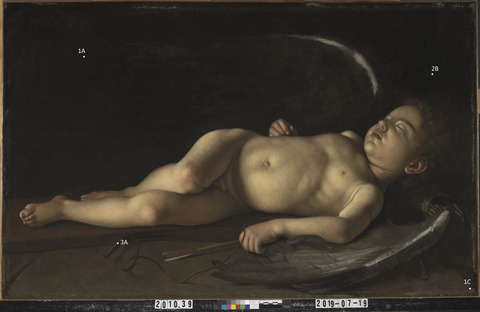
Materials/Binding Medium:
Cross-section samples from each of the three sections of canvas were taken to compare the ground structures (tech. fig. 4). The ground layer appears to be composed of the same elemental make up on all three sections of canvas and is made up of two distinct layers. A similar ground structure containing largely aluminosilicates was identified on the Crucifixion of Saint Andrew at the Cleveland Museum of Art.15
Ground Layer 1:
The first ground layer (tech. figs. 5, 9, 13; layer 1) is rich in aluminum, silicon, and calcium suggesting it is composed primarily of clay (aluminosilicates) and calcium carbonate (tech. figs. 5-16). Particles containing magnesium, titanium, and potassium, elements also found in clay, were detected in this layer. There are a few iron-rich particles scattered throughout the first ground layer suggesting some iron oxide (earth pigments) were added (tech. figs. 8, 12, 16). However, the density of iron oxide (earth pigments) is much lower than that of the clay particles (tech. figs. 6, 10, 14).16
Cross-section 3A
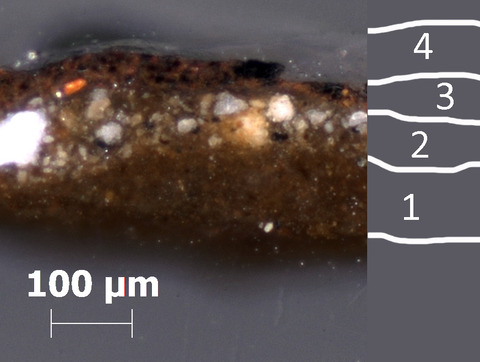
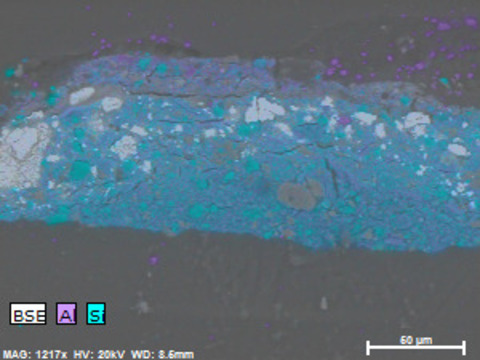
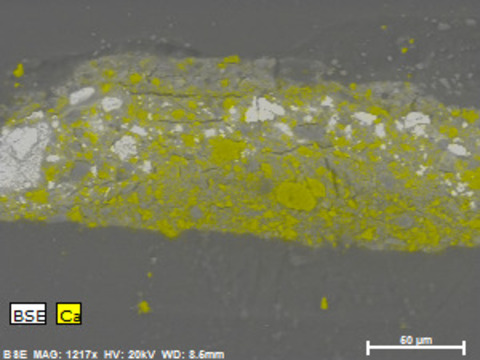
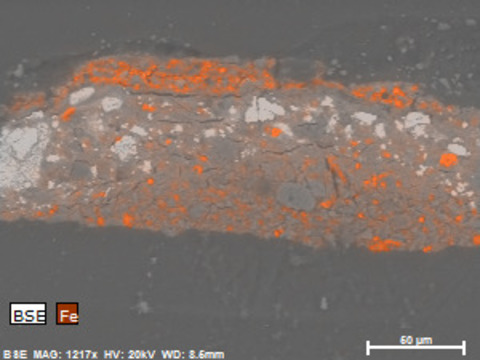
Cross-section 2B
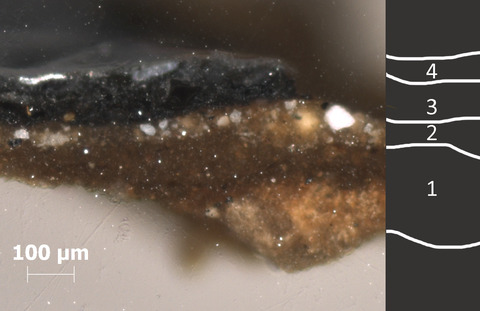
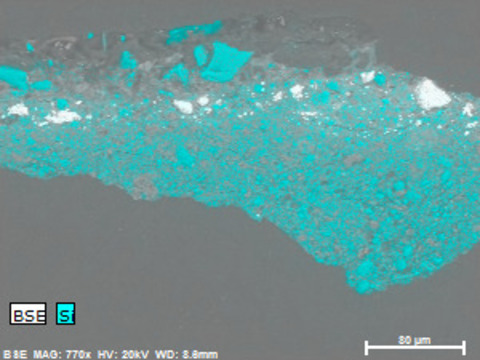
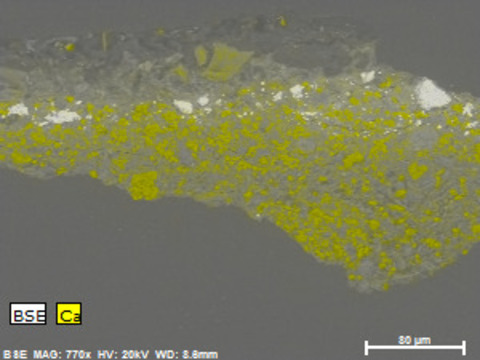
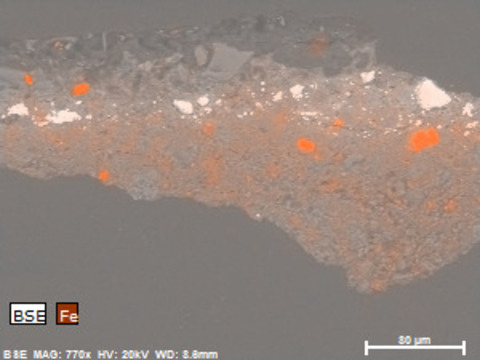
Cross-section 1C
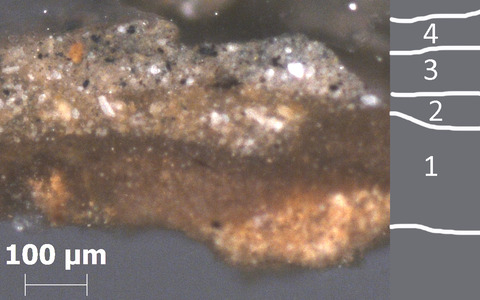
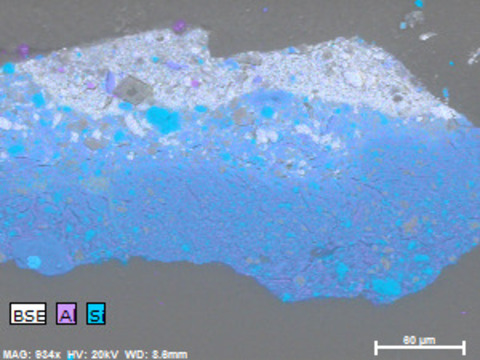
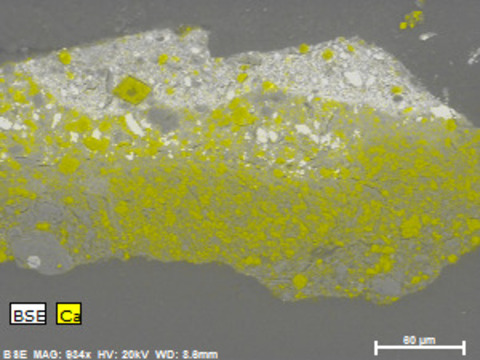
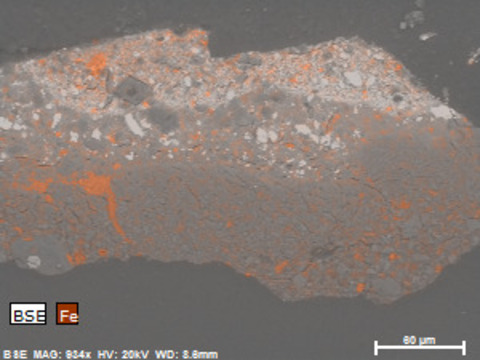
Ground Layer 2:
The second ground layer (tech. figs. 17; 19, 21, 23; layer 2) is visible on the canvas as a warm gray ground. This layer is left exposed in several areas of the painting. Ground layer 2 is similar in composition to the ground layer 1 (containing calcium carbonate, clay, and iron oxide pigments) with the addition of lead white (tech. figs. 18, 20, 22, 24), which appears to be confined to this ground layer 2, as well as the upper layers of paint. In cross section 1A, taken from the area of reworking, ground layer 2 is applied under the first composition (tech. fig. 17; layer 3) and again over the initial discarded composition that was blocked out as a means of preparing the canvas for a new composition (tech. fig. 17; layer 4).
Cross-section 1A
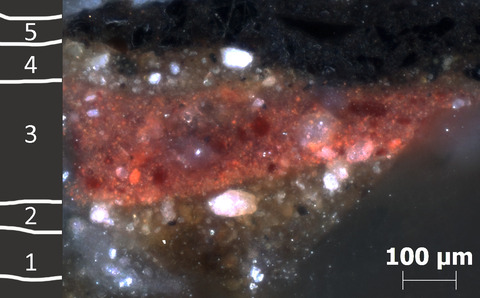
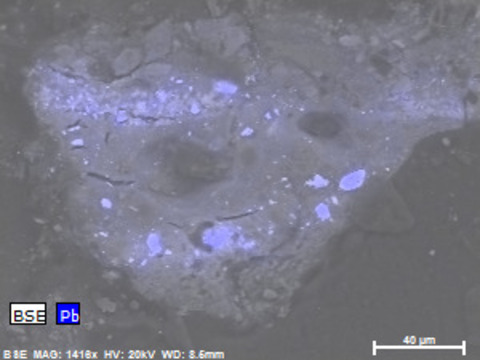
Cross-section 3A

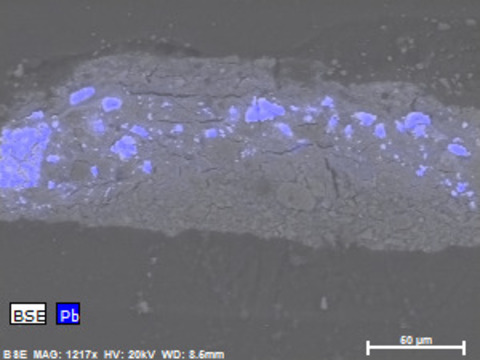
Cross-section 2B

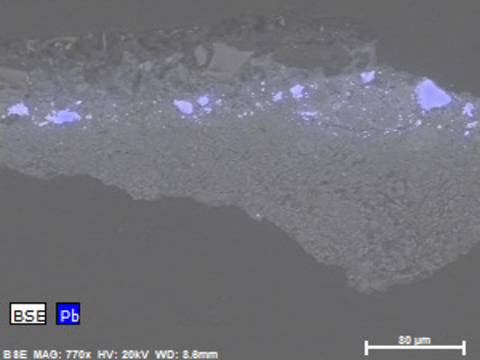
Cross-section 1C

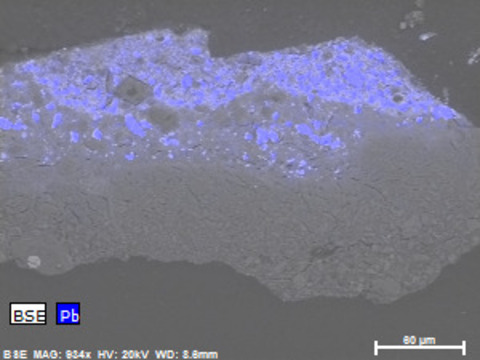
Color:
Ground layer 1 is a transparent brown color. Ground layer 2 is a warm gray color. Caravaggio was known to have painted primarily on dark red-brown grounds, as have been identified on the paintings in the National Gallery, London,17 and the Louvre. 18 However, early in his career Caravaggio did utilize gray grounds, often applied over commercially prepared canvases with darker grounds.19 It would be informative to study the ground structure on this version of the composition in comparison to that of the version in the Pitti Palace that has been dated 1608 and therefore aligns with the last few years of the artist’s career.
Application:
Cusping patterns, visible in X-radiograph, suggest canvas B and C were added after canvas A was primed (see Characteristics of Construction/Fabrication). Although the grounds on all three canvases have the same elemental composition, layer 1 in cross-section 2B and 1C is visually two distinct layers. It is possible the ground was applied in two layers on these canvases. More likely, the upper portion of the ground layer 1 (likely a glue ground) was saturated with oil from ground layer 2 and the upper layers of paint, causing it to darken and appear visually distinct from the lower portion of the layer. The slightly different visual appearance on canvas A (cross-section 1A, tech. fig. 17, and cross-section 3A, tech. fig. 19) may be explained by a different canvas preparation process.
Thickness:
Ground layer 1 is applied quite thickly on canvas B and C (tech. figs. 21, 23) but slightly more thinly on canvas A (tech. figs. 17, 19).
Sizing:
Although not visible in cross section, it is likely that the canvas was sized before the ground layers were applied.
Character and Appearance (Does texture of support remain detectable/prominent?):
The texture of the canvas is visible on the surface of the painting. This may, at least in part, be due to weave interference from the lining.
Condition of Ground
The ground is in generally good condition. There are no significant losses to the ground, and there do not seem to be adhesion problems. The ground has been abraded in several areas where a harsh cleaning intervention appears to have damaged the paint layer and ground leaving nubs of canvas exposed.
Description of Composition Planning
Methods of Analysis:
Surface observation (unaided or with magnification)
Infrared reflectography (IRR)
X-radiography
Analysis Parameters:
| X-Ray equipment | GE Inspection Technologies Type: ERESCO 200MFR 3.1, Tube S/N: MIR 201E 58-2812, EN 12543: 1.0mm, Filter: 0.8mm Be + 2mm Al |
|---|---|
| KV: | 21 |
| mA: | 3.0 |
| Exposure time (s) | 60 |
| Distance from x-ray tube: | 36” |
| IRR equipment and wavelength | Opus Instruments Osiris A1 infrared camera with InGaAs array detector operating at a wavelength of 0.9-1.7µm. |
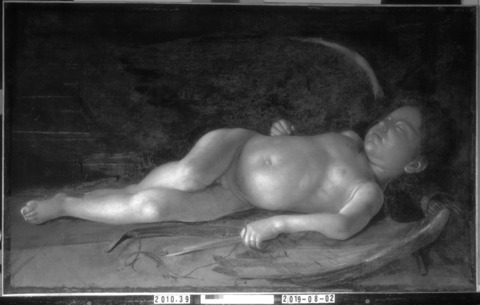
Medium/Technique:
There is no underdrawing visible in the infrared reflectogram (tech. fig. 25). This may be due to an infrared absorbent ground or the use of an underpainting that was carried out in materials— such as brown paint—that are not IR absorbing. The composition appears to have been established in some manner before painting began as there are not many adjustments to the composition. Black outlining that was applied in the painting phase is clearly visible.
Compositional Changes:
There is a previous composition visible in the upper-left quadrant of the X-radiograph (tech. fig. 26). The image appears to show a foreshortened face that has been subsequently blocked out with a second application of a lead-white-containing ground layer (see cross-section 1A, tech. figs. 17, 18). Friedlaender argued this face is similar to the head of St. Lucy in the Martyrdom of St. Lucy.20 The orientation of the face suggests that a previous composition may have been started in a different orientation. When the composition was abandoned, the canvas may have been reused, rotating it into a different orientation, trimming it on the top and right edges, and adding the canvas additions to make it long enough for the composition of Sleeping Cupid. This would account for the uneven cusping pattern around the canvas.
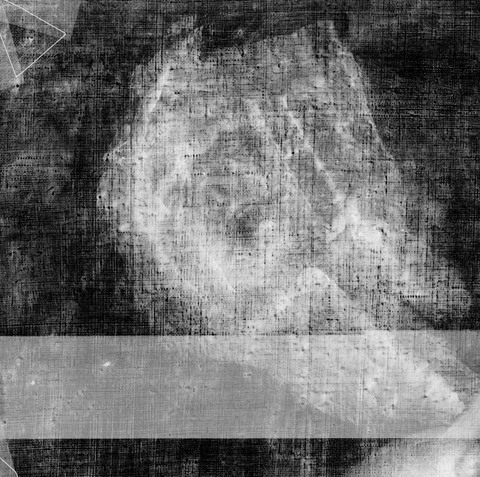
Several possible changes are also visible in the infrared reflectogram. The most prominent is in the wing near Cupid’s proper left hand (tech. fig. 27). A feather from the wing appears to have originally extended in front of the hand, much like the composition in the version of the composition attributed to Caravaggio now in the collection of the Pitti Palace, Florence, as well as several other versions of the composition. It is uncertain if this is a compositional change or inpainting that absorbs in infrared, as that area corresponds to inpaintings visible in ultraviolet-induced visible fluorescence (tech. fig. 38).
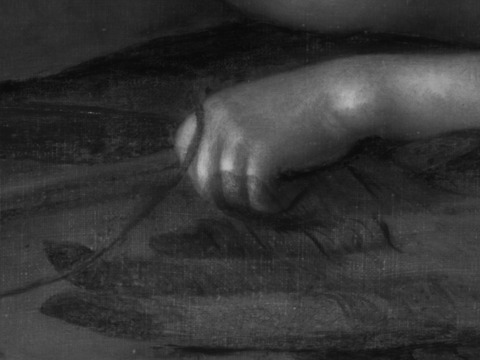
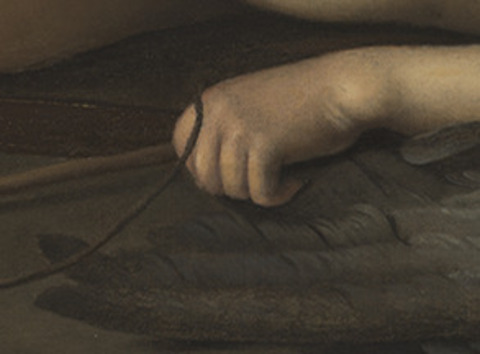
There may also be a pentiment along the face of the Cupid where the artist may have reworked the angle of the face, although it is difficult to say with certainty as this may be a result of abrasion rather than a reworking.
Description of Paint
Analyzed Observed
Application and Technique:
The severely abraded and flattened paint layer makes it difficult to comment on the order in which paint was applied or to judge the quality of the paint handling. Gentle blending of paint layers and subtle modulations in the skin are present in the ruddy ear and slightly curled toes. The slightly parted lips are created using a range of pink tones (tech. fig. 28). Brush strokes in the fingers are applied with confidence, and dabs of paint with low impasto suggest an artist with a degree of expertise (tech. fig. 29). Other areas of the painting, such as the arch of Cupid’s foot, appear to have lost any delicately modulated shadows, resulting in a rather flat appearance.
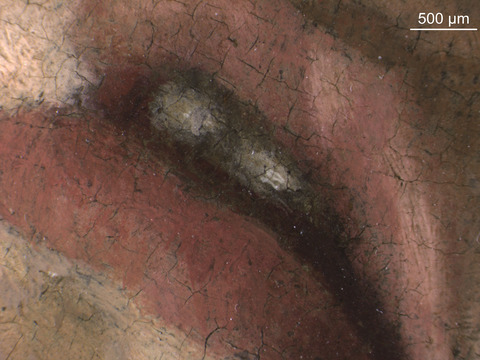
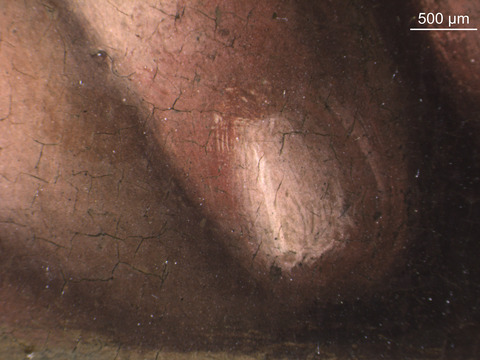
The Clowes painting does appear to have been carefully planned with only a few changes to the composition (see Compositional Changes). This may be a result of the composition being copied from a previous version of the painting now in the collection of the Pitti Palace. It is unclear how the artist translated the composition onto the canvas, as underdrawing or underpainting is not visible in infrared reflectography. However, the order of painting shows a carefully planned composition that likely was established either from a preexisting drawing or with an underpainted sketch.
The background was applied over the gray ground leaving a rough reserve for the figure. The background was likely painted around the painted sketch, which established the composition. Microscopic examination of the edges of the figure shows that the final layers of skin paint usually extend slightly over the background paint.
In the figure’s skin, areas of shadow appear to have been blocked in first over a gray midtone layer. The highlights were applied next, and a midtone was painted in to gently blend these layers. The shadows were reinforced with linear outlining, clearly visible in the infrared reflectogram (tech. fig. 30). It is likely that glazes were applied over these layers, but they have been largely abraded in subsequent cleaning interventions.
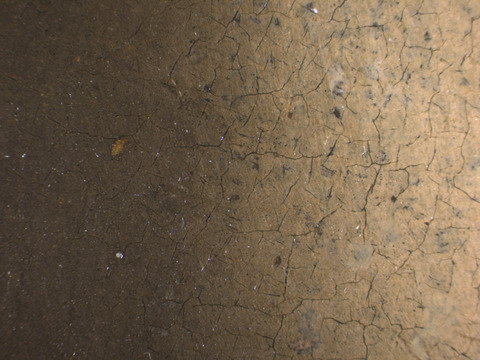
Gilded designs were applied on the arrows and sheath, which can also be observed on the Pitti Palace version.
In observing the Pitti Palace version of the Sleeping Cupid, IMA paintings conservator David Miller noted that, when compared to the Clowes version, the paint on the Pitti Palace version has a completely different texture and brushwork, with heavier paint application that more closely resembles other works by Caravaggio. With regards to the paint handling, he deemed the paint application in the Pitti Palace version to have more depth in the rib cage and a more purposeful application than that of the Clowes version.21
Painting Tools:
Medium-sized brush
Binding Media:
Oil (untested)
Color Palette:
The color palette is composed of mostly muted earth tones painted to create dramatic contrasts between bright highlights and dark shadows. There are a few passages of bright red pigment on the arrows and the skin. Gold-leaf detailing has been applied to the bow.
XRF analysis identified a limited palette containing lead white, iron oxide earth pigments (including umber), and calcium-containing pigment from the ground layer (see Description of Ground), and gilding composed of gold with some copper content (tech. fig. 34). Notably, no mercury was identified in the passages of red, suggesting that no vermilion was used in the red passages. Rather, red tones appear to have been painted using a red earth pigment possibly in conjunction with a red lake pigment (not identifiable using XRF). EDS analysis of cross section 1A from the area of reworking identified a red layer (tech. fig. 31 layer 3) that contained iron and aluminum, which was not associated with silicon (tech. figs. 32, 33). This suggests the layer was composed of iron oxide (earth pigments) mixed with a red lake pigment with an aluminum mordant. Carbon black was likely also used, but this could not be confirmed using XRF.

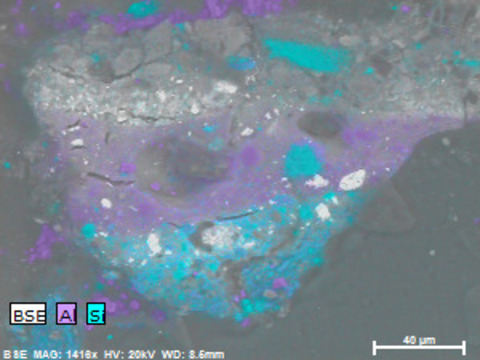
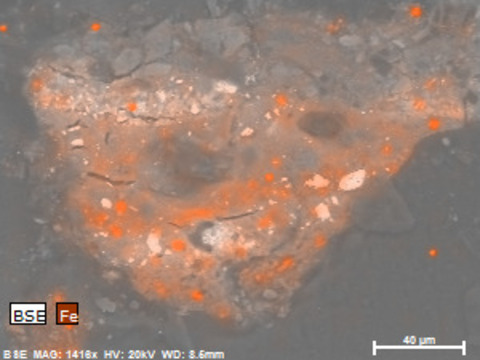
XRF Analysis
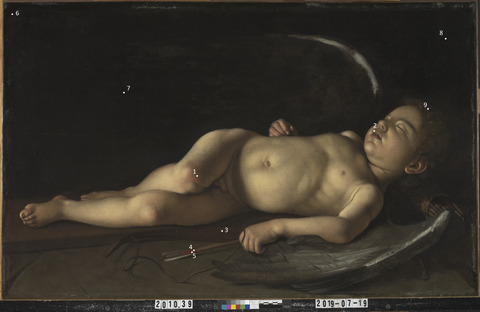
| Sample | Location | Elements | Possible Pigments |
|---|---|---|---|
| 1 | Cupid’s knee (38.5 cm from top, 60 cm from right) | Major: Pb, Fe Minor: Ca Trace: Mn | Lead white, iron oxide (earth pigments), trace of calcium (likely from ground). |
| 2 | Cupid’s upper lip (29 cm from top, 23.2 cm from right) | Major: Pb, Fe Minor: Trace: Ca, Mn | Lead white, iron oxide (earth pigments), trace of calcium (likely from ground). |
| 3 | Gilding on bow (50 cm from top, 56.5 cm from right) | Major: Au, Pb Minor: Fe, Cu Trace: Ca | Gold leaf with copper component, Lead white, iron oxide (earth pigments), trace of calcium (likely from ground) |
| 4 | Red arrow shadow (54 cm from top, 62 cm from right) | Major: Pb, Fe Minor: Trace: Ca, Mn | Lead white, iron oxide (earth pigments), trace of calcium (likely from ground), possible red lake pigment (not detectable using XRF). |
| 5 | Red arrow highlight (54.2 cm from top, 61.8 cm from right) | Major: Pb, Fe Minor: Trace: Ca, Mn | Lead white, iron oxide (earth pigments), trace of calcium (likely from ground), possible red lake pigment (not detectable using XRF). |
| 6 | Black background section A (5.5 cm from top, 5.5 cm from left) | Major: Pb, Fe Minor: Ca, Mn Trace: Zn, Cu | Lead white, iron oxide (earth pigments including umber), trace of calcium (likely from ground), trace of zinc from inpainting |
| 7 | Black background with pentiment (21 cm from top, 21 cm from left) | Major: Pb, Fe Minor: Trace: Ca, Mn | Lead white, iron oxide (earth pigments including umber), trace of calcium (likely from ground) |
| 8 | Black background section B (15 cm from top, 6 cm from right) | Major: Pb, Fe Minor: Ca, Mn Trace: K | Lead white, iron oxide (earth pigments including umber), trace of calcium (likely from ground) |
| 9 | Yellow curl (23.8 cm from top, 11 cm from right) | Major: Pb, Fe Minor: Ca Trace: K | Lead white, iron oxide (earth pigments), trace of calcium (likely from ground) |
| 10 | Gray background section C (3 cm from bottom, 4.5 cm from right) | Major: Pb, Fe Minor: Ca Trace: | Lead white, iron oxide (earth pigments), trace of calcium (likely from ground) |
Table 2: Results of X-ray fluorescence analysis conducted with a Bruker Artax microfocus XRF with rhodium tube, silicon-drift detector, and polycapillary focusing lens (~100μm spot).
*Major, minor, trace quantities are based on XRF signal strength not quantitative analysis
Surface Appearance:
The surface of the painting has been severely altered over the course of its lifetime. There appears to have been some degree of impasto in highlighted areas that were flattened likely during lining.
Condition of Paint
Despite there being few complete losses, the paint layer has endured severe damage due to flattening of impasto during lining and harsh cleaning interventions, likely to remove old oil overpaint. The entire paint layer has suffered, but this is especially obvious in dark passages and in areas where delicate glazes would have created modulating tones. The dark background has been severely abraded as have the wings and skin (tech. figs. 35–37).
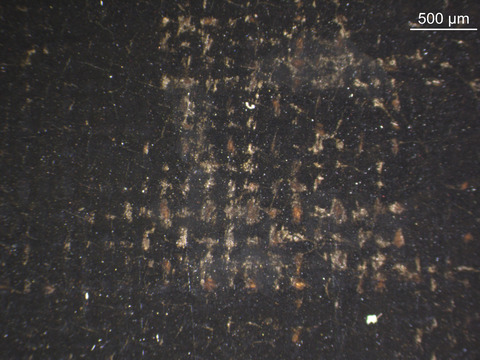
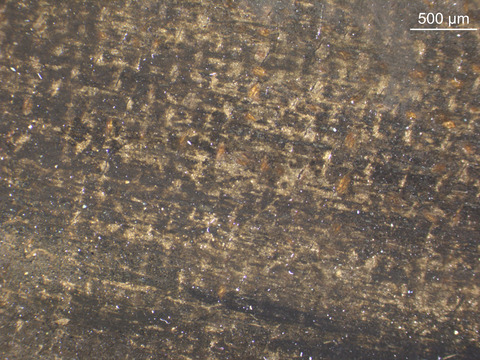
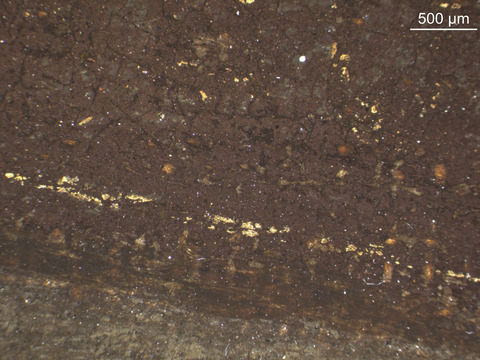
Description of Varnish/Surface Coating
Analyzed Observed Documented
| Type of Varnish | Application |
|---|---|
| Natural resin | Spray applied |
| Synthetic resin/other | Brush applied |
| Multiple Layers observed | Undetermined |
| No coating detected |
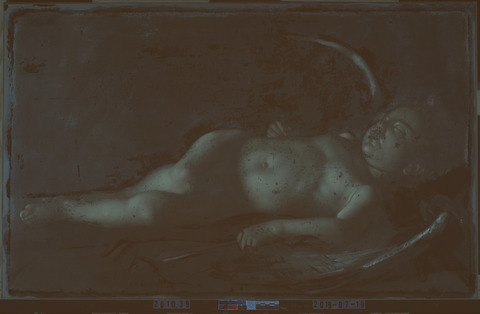
The painting has several layers of Paraloid B-72 that were applied during the treatments at the IMA (see Summary of Treatment History). Extensive inpainting is also visible in ultraviolet-induced visible fluorescence (tech. fig. 38).
Condition of Varnish/Surface Coating
The multiple varnish coatings have exhibited a history of blooming, prompting numerous interventions to saturate the dark, abraded surface of the painting. These interventions were moderately successful (see Summary of Treatment History). Extensive old inpainting had become desaturated and somewhat mismatched in color (tech. fig. 39). A 2019 intervention aimed to correct this issue through inpainting.
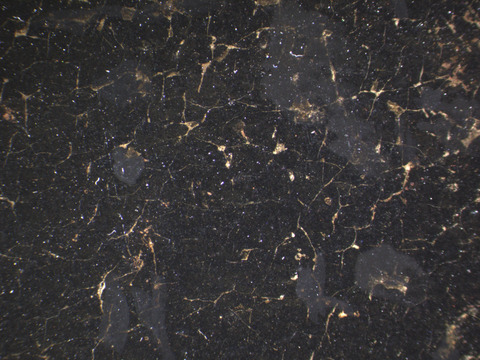
Description of Frame
Original/first frame
Period frame
Authenticity cannot be determined at this time/ further art historical research necessary
Reproduction frame (fabricated in the style of)
Replica frame (copy of an existing period frame)
Modern frame
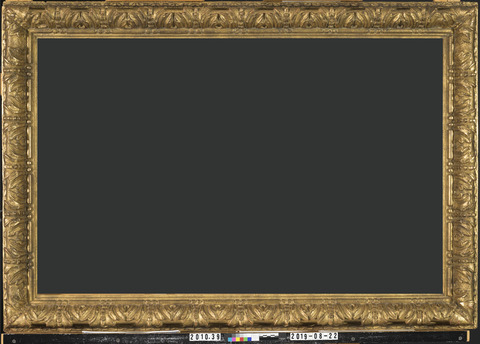
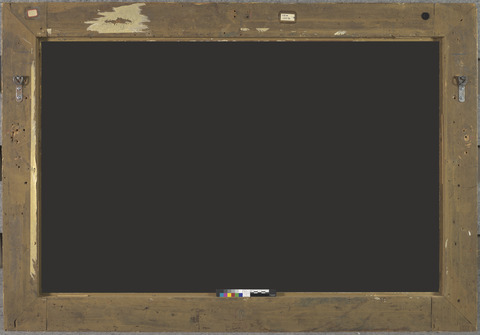
Frame Dimensions:
Outside frame dimensions: 87 × 126 × 9 cm
Sight size: 62.5 × 102 cm
Distinguishing Marks:
Back:
Item 3. “6734/13,” handwritten in pencil on paper label with a red outline, top-left corner of frame back. (tech. fig. 41)
Item 4. “TR#10016,” handwritten in pencil on paper label, top center of frame back. (tech. fig. 41)
Description of Molding/Profile:
The frame is a carved wooden frame with a repeated floral molding covered in a red bole with water gilding (tech. fig. 39). The decorative molding is reminiscent of late nineteenth-/early twentieth-century frames.
Condition of Frame
The frame is in good condition. The structure is stable and there are very few losses. The gilding is also intact and stable (tech. fig. 40).
Additional Notes or Comments
In preparation for a traveling exhibition, the frame was fitted with glazing in 2019, and a buildout was added to the back of the frame to accommodate the increased depth.
Notes
-
Walter Friedlaender, Caravaggio Studies (Princeton: Princeton University Press, 1955), 212. ↩︎
-
Walter Friedlaender, “The Sleeping Cupid by Michelangelo da Caravaggio,” December 1948, p. 1, Conservation Department Files, Indianapolis Museum of Art at Newfields. ↩︎
-
Paul A.J. Spheeris, “Conservation Report on the Condition of the Clowes Collection,” 25 October 1971, Conservation Department Files, Indianapolis Museum of Art at Newfields. ↩︎
-
Martin Radecki, Clowes Collection condition assessment, undated (after October 1971), Conservation Department Files, Indianapolis Museum of Art at Newfields. ↩︎
-
“Report on Condition/Conservation Report: SLEEPING CUPID,” undated (about 1970), p. 2–3, Conservation Department Files, Indianapolis Museum of Art at Newfields. ↩︎
-
Intermuseum Conservation Association, “Clowes Collection Conservation Report,” C10016 (2010.39), 8–10 April 1974, Conservation Department Files, Indianapolis Museum of Art at Newfields. ↩︎
-
Memorandum from Martin Radecki to Bret Waller, “Conservation work on Clowes Fund Collection,” 16 February 1996, Conservation Department Files, Indianapolis Museum of Art at Newfields. ↩︎
-
David Miller, IMA Conservation Department work request form, 19 April 200, Conservation Department Files, Indianapolis Museum of Art at Newfields. ↩︎
-
David Miller “Notes Re: Caravaggio CL10016,” 20 September 2000, Conservation Department Files, Indianapolis Museum of Art at Newfields. ↩︎
-
Martin Radecki, “Examination Report: Sleeping Cupid,“1 April 2003, Conservation Department Files, Indianapolis Museum of Art at Newfields. ↩︎
-
C. Richard Johnson Jr., Don H. Johnson, William A. Sethares, “Thread Count Report: Sleeping Cupid Follower of Caravaggio,” August 2019, p. 1, Conservation Department Files, Indianapolis Museum of Art at Newfields. ↩︎
-
C. Richard Johnson Jr., Don H. Johnson, William A. Sethares “Thread Count Report: Sleeping Cupid Follower of Caravaggio,” August 2019, p. 4, Conservation Department Files, Indianapolis Museum of Art at Newfields. ↩︎
-
Observations on canvas construction in this section drawn from Richard Johnson Jr., Don H. Johnson, William A. Sethares, “Thread Count Report: Sleeping Cupid Follower of Caravaggio,” August 2019, p. 4, Conservation Department Files, Indianapolis Museum of Art at Newfields. For more information on weft snakes, see C.R. Johnson, D.H. Johnson, I. Verslype, R. Lugtigheid, and R.G. Erdmann, “Detecting Weft Snakes,” Art Matters 5 (2013): 48–52, https://hdl.handle.net/11245/1.409955. ↩︎
-
“Materials and Equipment Used for the Construction of Stretchers and Strainers,” AIC Wiki, last edited 10 November 2019, http://www.conservation-wiki.com/wiki/PSG_Stretchers_and_Strainers_-_III._Materials_and_Equipment#A._HISTORICAL_AND_ORIGINAL_STRETCHERS_AND_STRAINERS. ↩︎
-
SEM/EDS identified a similar distribution of coarsely to moderately ground pigments, as well as bulking ingredients, in both ground layers. This included aluminosilicates (or clay) containing traces of titanium (possibly ilmenite), calcium carbonate, particles of iron, pyrite, magnetite, bone- or ivory-black-containing phosphorus, magnesium, and trace amounts of azurite-containing copper and vermilion-containing mercury. Email communication between Dean Yoder of the Cleveland Museum of Art and author. ↩︎
-
A study of three Caravaggio paintings in the National Gallery, London, found the grounds were not rich in clay but rather were composed of primarily calcite, earth pigments, lead white, and in one case, carbon black. Larry Keith, “Three Paintings by Caravaggio,” National Gallery Technical Bulletin 19 (1998): 38, 42, 45, http://www.nationalgallery.org.uk/technical-bulletin/keith1998b ↩︎
-
Larry Keith, “Three Paintings by Caravaggio,” National Gallery Technical Bulletin 19 (1998): 37–51, http://www.nationalgallery.org.uk/technical-bulletin/keith1998b ↩︎
-
A brown ground composed of chalk, lead white, and brown-red earth was identified on Caravaggio’s Fortune Teller. Maartji Stols-Witlox, “Grounds, 1400–1900” in The Conservation of Easel Paintings, ed. Joyce Hill Stoner and Rebecca Anne Rushfield. (London: Routledge, 2012), 173. ↩︎
-
Phoebe Dent Weil, “Technical Art History and Archeometry II: An Exploration of Caravaggio’s Painting Techniques,” Revista Brasileira de Arqueometria, Restauração e Conservação 1 no. 3 (2007): 108. ↩︎
-
Walter Friedlaender, Caravaggio Studies (Princeton: Princeton University Press, 1955), 212. ↩︎
-
David Miller, “Notes on Observation of Pitti Palace Version of Sleeping Cupid,” 1999, Conservation Department Files, Indianapolis Museum of Art at Newfields. ↩︎
Additional Images
